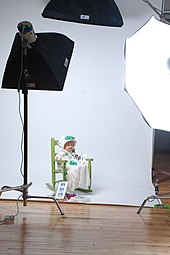Light shaper
Light shapers are aids for flash or continuous light systems in photo technology to control the light characteristics.
reflector
The simplest form of a light shaper is a reflector, which is attached to the lamp on the flash head or the luminaire and prevents the light from spreading uncontrollably. Inside, reflectors are usually coated in white or silver in order to achieve the highest possible light reflection. Depending on the color, the light can also be made softer by the reflector.
Softbox (striplight)
Softboxes, also called light troughs, are predominantly rectangular or octagonal boxes that are usually mounted on a lamp. Rectangular softboxes are usually square or have an aspect ratio of 1: 2. From an aspect ratio of 1: 3, they are also known as striplights . The rear part of a softbox is opaque and usually silver inside to achieve good light reflection. The front is covered with translucent fabric or foil. With a softbox you can achieve a more even illumination of subjects and reduce the formation of shadows. The light appears softer due to the softer transition to the shadows. By using several softboxes, you can achieve very good illumination and almost completely avoid shadows.
Surface reflector
A surface reflector, often just referred to as a reflector, is usually mounted on a tripod , on which it can be adjusted very flexibly in all directions by means of a special holder or held accordingly by an assistant. The rectangular or round reflectors enable the incident light to be deflected. They can be used with sunlight and with flash or continuous light systems. In addition, direct light can be prevented from falling on the subject and the shadow cast can be influenced. At the same time, the light color and quality can be influenced by the mostly white, silver or gold reflectors, with silver producing a cold, gold a warm and white a neutral, soft light.
Reflective and transmitted light umbrella
Similar to a surface reflector, the direction and color of the light can be influenced with a reflex umbrella. The screen is mounted directly in front of the light source so that the light is redirected in the other direction. Due to the opaque screen, the light is bundled compared to a surface reflector and can therefore be aligned more precisely. Reflex umbrellas are usually white, silver or gold, which can influence the light color.
The translucent umbrella does not reflect light, but achieves a more even distribution of the light, similar to a softbox.
Honeycomb filter
This attachment, which is mostly used in combination with other attachment light shapers, reduces the scattering of light. The more targeted alignment of the light ensures better and more detailed illumination of the subject.
Barn doors
With two or four barn doors (photographer's jargon : “barn doors”), which are usually attached to a reflector, you can also direct the light. The movable flaps enable flexible, also asymmetrical light guidance.
Light tube, narrow beam, spot attachment
Such attachments, which are attached either directly to the flash head or the lamp or to a reflector, narrow the light cone in such a way that one achieves point lighting. Such spot lighting is often used in combination with color filters to set off parts of the motif in color.
Light cube, light tent
The light tent or light cube is a special light shaper. It is a case that completely surrounds the motif. Photographs are taken through a small opening for the lens. The lighting is carried out by means of flashing or continuous light from the outside. This achieves an almost shadow-free and, above all, only minimally reflective illumination of a motif. Light tents are mainly used for the photography of strongly and difficult to calculate reflective objects such as glasses, cups, balls, etc.



